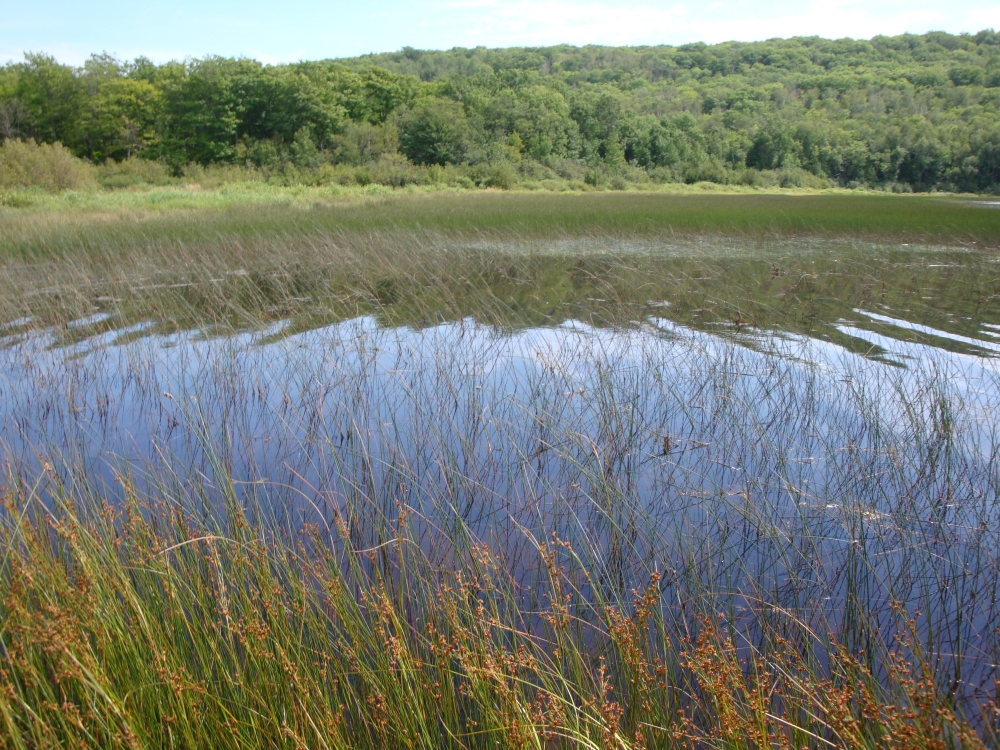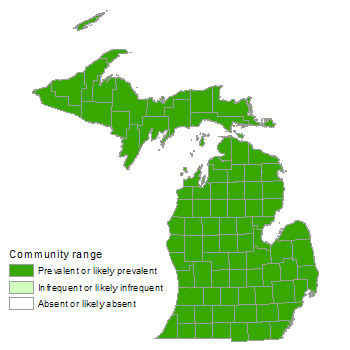Emergent Marsh
Overview
Emergent marsh is a shallow-water wetland along the shores of lakes and streams characterized by emergent narrow- and broad-leaved herbs and grass-like plants as well as floating-leaved herbs. Common plants include water plantains (Alisma subcordatum and A. triviale), sedges (Carex spp.), spike-rushes (Eleocharis spp.), pond-lilies (Nuphar spp.), pickerel weed (Pontederia cordata), arrowheads (Sagittaria spp.), bulrushes (Schoenoplectus spp.), and cat-tails (Typha spp.). The community occurs on both mineral and organic soils.
Rank
Global Rank: GU - Unrankable
State Rank: S4 - Apparently secure

Landscape Context
Michigan’s landscape is the result of recent continental glaciation, creating thousands of lake basins, drainage networks, and poorly drained depressions that support wetland vegetation. Emergent marshes line the margins of many streams and inland lakes, as well as protected portions of the Great Lakes shoreline, where it is classified as Great Lakes marsh.
Soils
Emergent marsh can develop on all textures of glacial sediment, including rock, gravel, sand, silt, or clay. Typically there is an accumulation of circumneutral to alkaline, fine organic sediments overlying the mineral soil. Where organic sediments are acid, the wetlands tend to develop into peatlands rather than remain as marsh.
Natural Processes
Emergent marshes are subject to frequent or seasonal flooding. Periods of low water facilitate seed bank expression and seedling establishment when litter levels are low. Beaver dams in nearby streams cause major changes to soils and vegetation. One of the most important results of flooding is the creation of oxygen-deprived sediments and accumulation of peat. Muskrat feeding within emergent marshes can create openings that are colonized by submergent and floating vegetation. Historically, where emergent marshes bordered fire-dependent uplands, wildfires likely burned across the community, reducing litter levels and facilitating seed bank expression and seedling establishment.
Vegetation
Emergent marsh is a broad wetland type, characterized by a wide diversity of emergent and floating-leaved plant species. Some of the more common species and genera include water plantains (Alisma subcordatum and A. triviale), sedges (Carex comosa, C. lacustris, C. lasiocarpa, C. oligosperma, C. stricta, and many more), spike-rushes (Eleocharis acicularis, E. elliptica, E. equisetoides, E. obtusa, E. quinqueflora, E. palustris, and others), manna grass (e.g., Glyceria borealis, G. canadensis, and G. striata), cut grass (Leersia oryzoides), small duckweed (Lemna minor), yellow pond-lily (Nuphar advena and N. variegata), sweet-scented water-lily (Nymphaea odorata), smartweeds (Persicaria amphibia, P. hydropiper, P. lapathifolia, and others), pickerel weed (Pontederia cordata), common arrowhead (Sagittaria graminea, S. latifolia, and S. rigida), bulrushes (Schoenoplectus acutus, S. pungens, S. subterminalis, and S. tabernaemontani), bur-reeds (Sparganium americanum, S. angustifolium, S. emersum, S. eurycarpum, S. fluctuans, and S. natans), great duckweed (Spirodela polyrhiza), cat-tails (Typha angustifolia and T. latifolia), water-meals (Wolffia spp.), and wild-rice (Zizania aquatica, state threatened, and Z. palustris).
Marshes often consist of distinct zones. Along the drier margins of the emergent marsh, grasses and sedges typically dominate. In the broad marshes along the Great Lakes shoreline, this grass-sedge-dominated zone is treated as part of the larger Great Lakes marsh. Along lakes and streams, the shallow, inner marsh protected from wave action or current is often dense, with considerable plant diversity. Closer to the open water, species diversity is reduced due to deeper water, more anaerobic conditions, and greater erosion by waves or current. Most species in the outer marsh are perennial rhizomatous plants strongly adapted to aquatic habitats.
For information about plant species, visit the Michigan Flora website.
Plant Lists
Submergent Plants
- coontail (Ceratophyllum demersum)
- muskgrasses (Chara spp.)
- common waterweed (Elodea canadensis)
- water star-grass (Heteranthera dubia)
- milfoils (Myriophyllum spp.)
- naiads (Najas flexilis, and others)
- stoneworts (Nitella spp.)
- pondweeds (Potamogeton spp.)
- submergent bulrush (Schoenoplectus subterminalis)
- bladderworts (Utricularia gibba, U. intermedia, and U. vulgaris)
- water-celery (Vallisneria americana)
Rooted Floating-leaved Plants
- water-shield (Brasenia schreberi)
- yellow pond-lilies (Nuphar advena and N. variegata)
- sweet-scented waterlily (Nymphaea odorata)
- large-leaved pondweed (Potamogeton amplifolius)
- Illinois pondweed (Potamogeton illinoensis)
Non-rooted Floating Plants
- small duckweed (Lemna minor)
- star duckweed (Lemna trisulca)
- red duckweed (Lemna turionifera)
- great duckweed (Spirodela polyrhiza)
- water meals (Wolffia spp.)
Emergent Plants
Graminoids
- sedges (Carex aquatilis, C. comosa, C. lacustris, C. lasiocarpa, C. oligosperma, C. stricta, and others)
- three-way sedge (Dulichium arundinaceum)
- spike-rushes (Eleocharis acicularis, E. elliptica, E. equisetoides, E. obtusa, E. palustris, E. quinqueflora, and others)
- manna grasses (Glyceria borealis, G. canadensis, and G. striata)
- cut grass (Leersia oryzoides)
- common reed (Phragmites australis subsp. americanus)
- hardstem bulrush (Schoenoplectus acutus)
- threesquare (Schoenoplectus pungens)
- softstem bulrush (Schoenoplectus tabernaemontani)
- wild rice (Zizania aquatica)
- northern wild rice (Zizania palustris)
Forbs
- water-plantain (Alisma subcordatum and A. triviale)
- pipewort (Eriocaulon aquaticum)
- smartweeds (Persicaria amphibia, P. hydropiper, P. lapathifolia, and others)
- pickerel-weed (Pontederia cordata)
- arrowheads (Sagittaria graminea, S. latifolia, and S. rigida)
- bur-reeds (Sparganium americanum, S. angustifolium, S. emersum, S. eurycarpum, S. fluctuans, and S. natans)
- broad-leaved cat-tail (Typha latifolia)
Ferns
- marsh fern (Thelypteris palustris)
Noteworthy Animals
Emergent marshes provide habitat to a broad diversity of aquatic invertebrates, many of which occupy and feed on decomposing vegetation. The invertebrates support numerous species of fish, amphibians (frogs), reptiles (snakes and turtles), waterfowl, water birds, and wetland mammals like muskrat (Ondatra zibethicus). Muskrats and beaver (Castor canadensis) can profoundly influence the hydrology of emergent marshes and surrounding wetlands. Muskrats create open water channels, and beavers can cause substantial flooding through their dam-building activities. Emergent marshes flood seasonally, especially in the spring, providing temporary habitat and spawning grounds for fish such as northern pike (Esox lucius), and many other organisms listed above.
Rare Plants
- Armoracia lacustris (lakecress, state threatened)
- Beckmannia syzigachne (slough grass, state threatened)
- Calamagrostis stricta (narrow-leaved reedgrass, state threatened)
- Callitriche hermaphroditica (autumnal water-starwort, state special concern)
- Callitriche heterophylla (large water-starwort, state threatened)
- Cyperus acuminatus (nut-grass, presumed extirpated from Michigan)
- Cyperus flavescens (yellow nut-grass, state special concern)
- Eleocharis caribaea (spike-rush, state threatened)
- Eleocharis equisetoides (horsetail spike-rush, state special concern)
- Glyceria acutiflora (manna grass, presumed extirpated from Michigan)
- Gratiola aurea (hedge-hyssop, state threatened)
- Hibiscus laevis (smooth rose-mallow, state special concern)
- Hibiscus moscheutos (rose mallow, state special concern)
- Justicia americana (water-willow, state threatened)
- Juncus militaris (bayonet rush, state threatened)
- Lemna valdiviana (pale duckweed, presumed extirpated from Michigan)
- Littorella uniflora (American shore-grass, state special concern)
- Mimulus alatus (wing-stemmed monkey-flower, presumed extirpated from Michigan)
- Myriophyllum alterniflorum (alternate-leaved water-milfoil, state special concern)
- Myriophyllum farwellii (Farwell’s water-milfoil, state threatened)
- Nelumbo lutea (American lotus, state threatened)
- Nuphar pumila (small yellow pond-lily, state endangered)
- Nymphaea tetragona ssp. leibergii (pygmy water-lily, state endangered)
- Potamogeton confervoides (alga pondweed, state special concern)
- Potamogeton hillii (Hill’s pondweed, state threatened)
- Ranunculus ambigens (spearwort, state threatened)
- Ranunculus macounii (Macoun’s buttercup, state threatened)
- Sabatia angularis (rose pink, state threatened)
- Sagittaria montevidensis (arrowhead, state threatened)
- Zizania aquatica var. aquatica (wild-rice, state threatened)
Rare Animals
- Botaurus lentiginosus (American bittern, state special concern)
- Chlidonias niger (black tern, state special concern)
- Emydoidea blandingii (Blanding’s turtle, state special concern)
- Ixobrychus exilis (least bittern, state threatened)
- Rallus elegans (king rail, state endangered)
- Sterna forsteri (Forster’s tern, state special concern)
Biodiversity Management Considerations
Eliminating off-road vehicle (ORV) traffic, nutrient and sediment inputs, dredging, ditching, and draining activity, and invasive species populations is integral to protecting the ecological integrity of high quality emergent marsh. Dredging for marl has destroyed many marshes along the edges of small lakes in eastern Upper Michigan and in portions of Lower Michigan. Ditching and subsequent drainage allow shrubs and trees to establish and eventually replace emergent marshes. ORVs can disturb sediments and introduce seed from invasive plants like purple loosestrife (Lythrum salicaria) and narrow-leaved cat-tail (Typha angustifolia). In addition to purple loosestrife and narrow-leaved cat-tail, invasive species that threaten diversity in emergent marsh include reed (Phragmites australis subsp. australis), reed canary grass (Phalaris arundinacea), hybrid cat-tail (Typha xglauca), frogbit (Hydrocharis morsus-ranae), watercress (Nasturtium microphyllum), and European marsh thistle (Cirsium palustre). Increased nutrient input in the form of runoff from agricultural fields and lawns, leaking septic systems, and sewage discharge can result in an expansion of invasive plants such as narrow-leaved cat-tail, hybrid cat-tail, reed, and reed canary grass, and accompanying loss of native plant and animal diversity. Increased sedimentation resulting from soil disturbances upslope creates ideal conditions for colonization and expansion of reed canary grass and purple loosestrife.
Where emergent marsh borders fire-dependent upland communities, management should include prescription burning of both the marsh and adjacent uplands to facilitate seed bank expression and seedling establishment.
Variation
Emergent marshes can be dominated by a diversity of emergent plants. NatureServe and many states and regions subdivide and name their emergent marshes on the basis of dominant species (e.g., spike-rush marsh, bulrush marsh, cat-tail marsh, etc).
Similar Natural Communities
Submergent marsh, Great Lakes marsh, intermittent wetland, coastal plain marsh, southern wet meadow, and northern wet meadow.
Places to Visit
- Lake of the Clouds, Porcupine Mountains Wilderness State Park, Ontonagon Co.
- Moss Lake, Proud Lake State Recreation Area, Oakland Co.
- South Portage Marsh, Waterloo State Recreation Area, Jackson Co.
Relevant Literature
- Albert, D.A. 2003. Between land and lake: Michigan’s Great Lakes coastal wetlands. Michigan Natural Features Inventory. Michigan State University Extension, East Lansing, MI. Bulletin E-2902. 96 pp.
- Cronk, J.K., and M. Siobhan Fennessy. 2001. Wetland plants: Biology and ecology. Lewis Publishers, Boca Raton, FL. 462 pp.
- Faber-Langendoen, D., ed. 2001. Plant communities of the Midwest: Classification in an ecological context. Association for Biodiversity Information, Arlington, VA. 61 pp. + appendix (705 pp.).
- Hutchinson, G.E. 1975. A treatise on limnology. Volume 3. Limnological botany. John Wiley and Sons, New York, NY. 660 pp.
Citation
Cohen, J.G., M.A. Kost, B.S. Slaughter, D.A. Albert, J.M. Lincoln, A.P. Kortenhoven, C.M. Wilton, H.D. Enander, and K.M. Korroch. 2020. Michigan Natural Community Classification [web application]. Michigan Natural Features Inventory, Michigan State University Extension, Lansing, Michigan. Available https://mnfi.anr.msu.edu/communities/classification. (Accessed: November 27, 2025).
Kost, M.A., D.A. Albert, J.G. Cohen, B.S. Slaughter, R.K. Schillo, C.R. Weber, and K.A. Chapman. 2007. Natural Communities of Michigan: Classification and Description. Michigan Natural Features Inventory, Report No. 2007-21, Lansing, MI.


